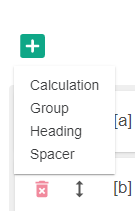Is there a way group certain expense line items together (i.e., group all payroll accounts together and have it subtotal to Total Payroll)? I guess my question is there a way to group accounts based on Level2PL? Any financial statement I’ve ever looked at (or created) has the expenses categorized somehow. Phocas lumps everything into Operating Expenses. I know there is something I’m missing. There’s no way the Phocas statements would be this rudimentary. Thanks for any insight anyone can provide.
Hi @wpratt ,
The original version of Financial Statements was as you described, however the new version of FS is far more comprehensive. My clients business has fully transitioned to this system and the P&L structure is pretty complex. If you open up your P&L and go to the star icon (top right) you should see the “Statements” menu option. Once you open this you can craft your own hierarchies with calculations. For example to work out EBITDA this is calc on many of the sub categories on the P&L:
The above image is a snippet of the structure, notice there are bespoke groupings and then we can have calculations on those groups.
With the groups created, you need to map the GL accounts to the correct groupings. this is also done within this dialog box:
I am not sure on the pricing model if you get V1 FS as a starting point and then need to purchase v2 which gives you in my opinion a very capable and versatile P&L platform. More can be found on the help pages here: https://helpphocassoftware.atlassian.net/wiki/spaces/userdoc/pages/373950260/Phocas+Financial+Statements?src=search
Did find this, so you may need to talk to your account manager:
This section is all about the latest **Phocas Financial Statements** product. If you're interested in accessing the features in this product please contact your Phocas account manager or Support in your region.
Regards,
Jon
Thank you @JonKemp . That is very helpful. One follow up question. In your above example you have a group for Repairs & Maintenance. Is that a field you created in the Mapping column within the dialog box. I’m no sure if I have that access but I would guess our Controller does. Thank you again for your assistance.
Hi,
This group was created within Phocas. Notice on the screenshot there is a plus in the top left corner?
Clicking on that brings up this option:

This is where we can create the EBITDA calculation or a group which you can then map to your GL accounts. Finally Heading and spacer are to beautify your P&L with additional titles and gaps.
So for example I created a group called “Repairs & Maintenance”, I then jumped to the mapping screen and then selected the GL accounts that I want under there:
All I did was selected the row of the GL account and there is a mapping button where you get a list of all the groups you have created (on the snippet above), its then a simple case of mapping accounts to your bespoke groups.
A word on your comment “I’m no sure if I have access but would guess our controller does”, you can have multiple hierarchies, this mapping option, its VERY useful. If you are multi company organisation you may find the P&L structure could be different for each company. For me, were are in the UK but the parent company is in the US and they want the P&L displayed differently, bottom line, the net profit is the same but how you display the categories could be different. Real life example is the definition of Net invoice sales, the UK includes rebates, whereas the US excludes rebates and add them further down the P&L, this can be easily catered for in Phocas. The menu above the two screenshots shown is where you can create multiple different hierarchies:
Notice how row 1 and row 3 are both profit and loss hierarchies, same data but different groups and mappings, both resulting in the same net profit line but how its depicted on screen is different.
I thought it was worth mentioning that you could have a hierarchy that is the “official” structure but you could then make additional ones without impacting the production version. The end user can then simply select the appropriate statement hierarchy:

@JonKemp thanks for answering this question so comprehensively.
Nick



